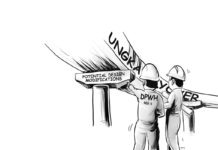
[av_one_full first min_height=” vertical_alignment=” space=” custom_margin=” margin=’0px’ padding=’0px’ border=” border_color=” radius=’0px’ background_color=” src=” background_position=’top left’ background_repeat=’no-repeat’ animation=”]
[av_heading heading=’MORE VITAL THAN EVER ‘ tag=’h3′ style=’blockquote modern-quote’ size=’30’ subheading_active=’subheading_below’ subheading_size=’15’ padding=’10’ color=” custom_font=”]
BY EDGARDO J. ANGARA
[/av_heading]
[av_textblock size=” font_color=” color=”]
Saturday, September 9, 2017
[/av_textblock]
[av_textblock size=’18’ font_color=” color=”]
EXTREME weather has been causing death and destruction in many parts of the world. In August, Hurricane Harvey barreled through the Caribbean and the Gulf of Mexico before making landfall in the United States, where it devastated a huge swath of Texas and Louisiana. In 6 days, Hurricane Harvey dropped a record-breaking 27 trillion liters (51 inches) of rain, leaving up to 30,000 people in need of temporary shelter. Economic losses have been estimated to range from US$70 billion to US$190 billion. Sadly, 65 lives were lost.
While Houston and many parts of Texas were drenched, an intense Los Angeles heat wave led to forest fires in La Tuna Canyon last Friday, burning over 5,895 acres — around 23.86 square kilometers — of brush and forcing nearly a thousand people to evacuate.
In July, heavy rains over Southern China caused the Yangtze and more than 60 other rivers and lakes to overflow, leading to massive floods and landslides — affecting nearly 12 million people and killing up to 56. The damage and destruction spread across 11 provinces. The Guangxi province alone incurred up to US$430 million in damage to infrastructure and economic losses.
Meanwhile, heavy monsoon rains over India, Bangladesh, and Nepal have led to massive flooding that displaced nearly 41 million and damaged or destroyed up to 950,000 homes. According to the International Federation of Red Cross and Red Crescent Societies (IFRC), around 1,200 people have already died since the rains started to fall in June.
Also in June, the central municipality of Pedrógão Grande in Portugal saw the start of the Iberian country’s worst forest fire in history which burned up to 300 square kilometers. Similar to Los Angeles, Portugal was at the time experiencing a particularly intense heat wave. Sixty-four (64) people were killed, most of whom were caught inside their cars as the surrounding brush ignited in a blaze. The main fire was quickly extinguished but by August, the Portuguese government needed to ask for help from other European Union (EU) members to douse up to 250 separate, though significantly smaller, fires.
A month earlier, the Famine Early Warning Systems Network (FEWS NET) created by the USAID calculated that up to 2.9 million Somalians were in dire need of emergency food aid. Below-average rainfall throughout 2016 and early 2017 led to droughts that as of April have already claimed 524 lives, from hunger but also disease.
In March this year, the New York Times wrote that drought — exacerbated by war — could lead to famine not just in Somalia, but also South Sudan, Nigeria, and Yemen. And with up to 20 million lives, international aid officials said that they could face the greatest humanitarian disaster since World War II.
Such weather-induced death and destruction happened across several countries in different countries simultaneously or sequentially only within the past three to six months. Each clearly demonstrates that climate change is real and already here, causing deep human grief.
There is wide scientific consensus that global warming — induced by carbon-intensive activities of man — has brought about all this disaster, destruction, and death. But does the average Filipino know about this connection? Are they personally affected, even if they have had their share of such climate-change related tragedy?
More importantly, do our policymakers take climate change risks into account in the rules and laws they make?
In the “Build, Build, Build” program, which may be the country’s most ambitious infrastructure development plan, but only has one or two projects that deal with flood management, or disaster risk reduction?
Or in the Tax Reform for Acceleration and Inclusion (TRAIN), where the version passed by the House (HB 5636) earmarks the extra revenues to social programs that will benefit many Filipinos, but makes no mention of climate change? (angara.ed@gmail.com| Facebook & Twitter: @edangara)/PN
[/av_textblock]
[/av_one_full]



